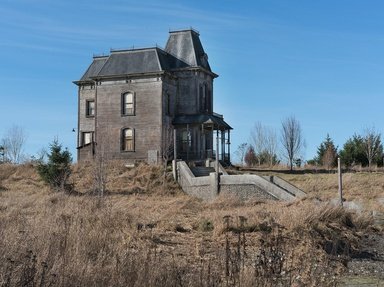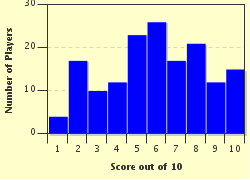Quiz Answer Key and Fun Facts
1. Alfred Hitchcock's first Hollywood film was "Rebecca" (1940). Based on the book of the same name written by London born novelist Daphne du Maurier, the film turned out to be a smash success. "Rebecca" received 11 Academy Award nominations, including Lawrence Olivier for Best Actor. "Rebecca" also received the nomination for Best Actress. Which classy actress played the leading female role?
2. "Lifeboat" (1944), a film set entirely in the Atlantic Ocean during World War II, is the story of the fight to survive for nine people thrust together in a lifeboat. Most of them were on a ship that was torpedoed by a German U-boat. They must deal with storm-tossed seas, caring for the wounded, dwindling supplies of food and water, and ultimately making the difficult decision of who should be allowed to stay aboard and live and who should die. A likely candidate to get tossed is Willi, a German seaman they plucked from the sea and who was on the U-boat that torpedoed them. It was a pretty small cast so can you recall who played the nasty Nazi?
3. Just four years before leaving home to come to America, Hitchcock directed "The 39 Steps" (1935). It is one of the most famous films he directed in England. The spy thriller, about an innocent man being chased down for a murder he didn't commit, starred Robert Donat and Madeleine Carroll. As per his idiosyncratic trademark of making a very brief appearance in his flicks, sure enough Hitch once again managed to find a way to pop up in this one. What was his cameo role in this movie?
4. "To Catch a Thief" (1955) starred the suave, debonair Cary Grant and the glamorous Grace Kelly in a light-hearted mystery set in Europe. A cat burglar is operating at an alarming rate, and the police notice the modus operandi is similar to one John Robie (Cary Grant), whom they seek to question. In what part of Europe do the police set out to catch a thief?
5. In the pulse-pounding suspense film "The Man Who Knew Too Much" (1956), we meet a typical American family on vacation abroad. James Stewart is Dr. Ben McKenna, Doris Day is his perky wife, Jo, and they are accompanied by their son, Hank (Christopher Olsen). What can go wrong, right? Wrong. A dying man tells Ben about an assassination plot against a foreign diplomat, and others want to stop the good doctor before he can alert the authorities. In what European capital is the hit supposed to take place?
6. In 1954, "The Master of Suspense" brought us the claustrophobic thriller "Rear Window". It starred James Stewart as L.B. Jeffries, a professional photographer who spends most of the film recuperating from a broken leg. Bored out of his mind, he passes his wheelchair bound days by observing the courtyard below his apartment, as well as the other residents. In time, he is convinced that one of his neighbors has killed his bedridden wife and disposed of her corpus delicti. The actor who played the hulking neighbor that Jeffries suspects of the murder, Lars Thorwald, would later star in a famous series. Name this thespian.
7. A year before moving to America, Alfred Hitchcock directed his next-to-last European film, "The Lady Vanishes" (1938). It's a comedy-mystery revolving around a trainful of people bound for England who get delayed by an avalanche, and must spend a night in the (fictional) countryside of Bandrika. While there, one of the passengers, a Miss Froy, is thought to have witnessed a murder. After someone unsuccessfully attempts to kill her but fails, she gets back on the train and promptly disappears. Who played the vanishing Miss Froy?
8. In one of Hitchcock's dark comedies, "The Trouble with Harry" is that he is no longer among the living. After his body is found on a local hillside, several townfolk each believe that they are somehow the person who knocked him off. Naturally none of them want the body found or any questions leading back to them from the local sheriff. Unbeknownst to each other, a series of burials, exhumations, burials, exhumations ensue. The cast that included John Forsythe and veteran Edmund Gwenn also marked the film debuts of a future famous actor and actress. The actor was young Jerry ("The Beaver") Mathers. Who was the debuting damsel?
9. In 1963 Hitchcock came up with an idea that was for "The Birds". Well, actually the idea originated in a short story written by Daphne du Maurier which was first released in 1952. "The Birds" tells the chilling tale of frenzied attacks by our formerly fine-feathered friends. For no apparent reasons thousands of birds begin attacking people creating panic and death among the populous in northern California. In "The Birds", Tippi Hedren played in her first Hitchcock directed film. Who played the lead male role?
10. No quiz about the wondrous works of Alfred Hitchcock would be complete without including "Psycho" (1960). Filmed in B&W, it grossed $40,000,000 after a cost of $800,000 and was his highest grossing film (and perhaps his most famous as well). The story line is about a secretary who purloins $40,000 from her boss and then skips town. The search for her leads her sister and a private investigator to the Bates Motel (Norman Bates, Prop.), where she had stayed a night after being forced to rest after driving all evening in a blinding rainstorm. Most folks know Janet Leigh played the stealing secretary, Marion Crane, and that Vera Miles played the sister who hired a P.I. to help find her. Who played private investigator Milton Arbogast?
Source: Author
paulmallon
This quiz was reviewed by FunTrivia editor
jmorrow before going online.
Any errors found in FunTrivia content are routinely corrected through our feedback system.

